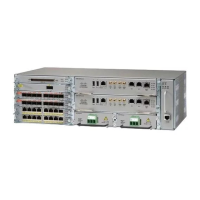43
Cisco IOS XE 3S Release Notes for the Cisco ASR 903 Router
OL-26630-08
Chapter
Caveats in Cisco IOS XE 3.7S Releases
• CSCud49980
Symptom: The router does not learn remote Connectivity Fault Management (CFM) Maintenance
Endpoint (MEPs).
Conditions: Occurs when you configure CFM MEPs on carrier edge (CE) routers and VPLS on
provider edge (PE) routers.
Workaround: Create an EVC bridge-domain running CFM on the PE router and enable a virtual
forwarding interface (VFI) on the bridge-domain.
• CSCud50851
Symptom: The router experiences flapping on REP connections.
Conditions: Occurs when you enable MAC limiting at a high scale and the set of MAC addresses
changes continuously.
Workaround: Disable MAC limiting.
• CSCud50944
Symptom: The router drops traffic on an MLPPP bundle.
Conditions: Occurs following a reload while the router is passing traffic close to the line rate. The
issue occurs less frequently with lower traffic rates.
Workaround: Issue a shutdown/no shutdown on multilink interface.
• CSCud52920
Symptom: SFP interfaces tied to a port-channel flap.
Conditions: The issue occurs rarely when the router is passing a high traffic volume.
Workaround: There is no workaround.
• CSCud56071
Symptom: The router does not pass loop-free alternate (LFA) IP fast reroute (IPFRR) traffic.
Conditions: Occurs when the router is configured with 10 or more IPv4 prefixes.
Workaround: Configure 9 or fewer prefixes.
Resolved Caveats—Cisco IOS XE Release 3.7(2)S
This section documents the issues that have been resolved in Cisco IOS XE Release 3.7(2)S.
• CSCua62029
Symptom: The router crashes.
Conditions: Occurs when you configure a class-based QoS policy with the following
characteristics:
–
The policy is attached to the main interface.
–
The policy classifies on multiple VLANs.
–
The classification statements specify a priority.
–
The classification statements are within a child QoS policy.
Workaround: There is no workaround.
• CSCua73104

